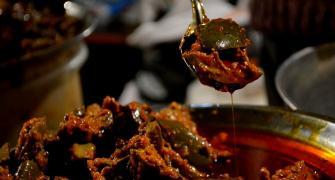
Need a kilo of tomatoes? You can have it in 15 minutes. Call the sabzi man and ask him to deliver. Or, better, BlinkIt, Zepto, Swiggy, BB, zap-zoom-whoosh it -- jo bhi -- and, ta-da, it's there.
Those olden-golden days of setting out for the bazaar, with plastic baskets, cloth thailas, and identifying your own fruits and vegetables, are long gone for many of us.
There was a fancy art to examining, poking, prodding, tickling or feeling up a baingan (eggplant) or gobhi (cauliflower), to ensure you were choosing the best of the offering.
To be honest, I don't have a clue how to do it. And just like the nonplussed men, who often open up the bonnets of their cars, to pretend to find what's wrong, while in markets I do my best simulation of how grannies and aunties do their inspections and beady-eyed jab or scrutinise doodhis and massage bhindis, as if I know what I am doing as I purchase my veggies.
The app-based grocery delivery services, with their indisputable convenience, have also taken away our trips to the markets.
How exciting they used to be! Especially in smaller towns. I am always inexplicably drawn to the raunak or glitter/shine of these "vernacular" markets (as my friend Sumit Bhattacharya calls them; a term he learned from his dad).

In Kanke, a wee village outside Ranchi, where we once lived, the biweekly haath was an enormous occasion -- an exciting carnival. There was another even bigger haath nearby at Pithoria on two other days of the week.
Villagers would come from miles around with their crop to these haaths and set up little roomal-size stalls, with pyramids of parval (pointed gourd), cabbage, cauliflower, tindli (ivy gourd, called kundru in Ranchi), piles of spinach, snowy radish, red greens and clusters of alu or baingan or doodhi, and much else, for sale.

The market sold a lot more than vegetables. Adjacent was a meat and fish section, that you could not bear to look at, so grisly were the goings on there, beyond which bloody cock fights took place.
Between the sabzi displays, grain, dal, papad, mung badis, teesi (flaxseed balls) etc could be bought.

There were numerous other stalls, some gaily decorated by the windblown, bright pheetas (hair ribbon) that they were selling, along with trinkets, dus-paisa toys, bindis, nada, safety pins, sari falls, petticoats, soap.
Adjoining them were open-air chappal shops. And vendors peddling baskets and locally-woven grass mats or chatais. Bangles sellers too.
The gaoti-style candy stand sold hard-boiled sweets, Kashmiri chutney (a tamarind concoction), Harnik Phantom sweet cigarettes, Poppins, Parle orange balls or the santra candy.

Amongst the rows and rows of goods, temporary paan vendors and tea stalls would come up offering garam garam chai, no matter how hot the day, and random snacks in a wood-frame glass boxes like nimki, laddus, pethas (the favourite of flies and wasps), mukri, jalebis, soan papdi.
The jhalmuriwallah also did brisk business, as did the kakri and seasonal fruit hawkers, who would sell his goodies on a tray balanced on a conical cane stand -- they would spice up the slices of cucumber or phalsa or ber or whatever it was, and serve it on a bright green leaf.

Barbers would set up their chairs on the side of the road so men might get their twice-a-week shaves (I think people shaved pretty infrequently in those parts) or their hair cut.
Lottery shops, located in cycle rickshaws, with loudspeakers attached, sold tickets and announced humongous prize money via a convincing sales pitch. Desi davawallahs spread out their mysterious, slightly scary-looking wares, many of them rostrums for boosting virility, on plastic sheets.

The other commodity much in demand was, of course, gossip. Everywhere two or three public log would gather, sitting on their haunches, chewing the fat, discussing inflation, the price of pyaz, their in-laws and the even older, even better days.
City markets, like those in Bombay, have their own charm, even if a little faceless and impersonable. They literally explode with goods and the hurried pace, noises and smells are far more overpowering, unlike the quaint, lazy village markets. They are, obviously, for urban-dwellers, still the preferred way to get the freshest vegetables.
So how should you pick your sabzi, if you don't let it Swiggy do it for you? Some tips from long-standing colleague and friend Savera R Someshwar, who is pretty good at it, and a few others:
Lady's fingers or bhindi: Bend the tail end. If it breaks, the bhindi is fresh.
Eggplant or baingan: Should feel springy. The skin should look fresh.
Tomatoes: Firm to the touch. Not squishy.
Potatoes: No green patches.
Onions: No black patches under the skin.
Lemon: Strong fragrance.
Carrots: Very firm to touch. Not wrinkled. The skin should be uniform without patches.
Cauliflower: Sparkling white. No black spots or patches.
Ginger: Fresh looking, not overly dried out. You can break one of the smaller nodules. If it breaks easily and the inner part is yellow and moist, it's good.
Peas: Soft, green pods, with not too large peas inside.
Avocadoes: Hold it in your palm and squeeze gently. If it yields slightly, it's ripe, if it's hard, avoid unless you are ready to wait for it to ripen.
Green bananas: Not too small, firm.
Cucumber: The ends should not be mooshy or dried. Firm. Green yellow, not too yellow.
What recipe would you like to cook with your perfectly-selected veggies? How about two types of tadkaris? Cauliflower and masala-stuffed bhindi.
The cauliflower is a Tamil-ish type preparation. It's a dish I have eaten at banana leaf wedding feasts and is quite different from how it is made in other parts of India.

Wedding Feast Cauliflower
Serves: 2-3
Ingredients
- ¾ kg cauliflower, thick stem, stalks and leaves discarded
- 1 medium carrot, peeled, grated
- 2 tsp grated ginger
- 1-2 green chillies, cut lengthwise
- 3 tsp ghee or cashew butter
- 10-12 curry pattas or curry leaves
- 1½ tsp rai or mustard seeds
- 2 tsp white urad dal or white gram
- ½ tsp hing or asafoetida
- 1½ tsp salt
- 2-3 tbsp grated fresh coconut, optional
Method
- Grate half of the cauliflower and finely chop the other half.
Keep aside. - Heat the ghee in a kadhai or frying pan over medium heat.
Add the urad dal, rai, hing and fry for about a minute till the urad dal turns pinkish and the rai has finished popping.
Add the curry pattas and then the finely chopped cauliflower and fry for 8-10 minutes till semi-cooked.
Then add the ginger, salt, green chillies, grated carrot, grated cauliflower, grated coconut and fry, tossing frequently, for 5-6 minutes more till cauliflower is cooked. - Serve hot with rasam or sambar, steamed rice, pickle and appalams (rice papads).
Zelda's Note: For a Jain version skip the carrot and use ½ cup finely chopped beans and opt for 1 tsp saunth or dried ginger powder instead of fresh ginger.

Bharwan Bhindi
Serves: 3-4
Ingredients
- ½ kg long bhindi or lady's fingers or okra
- 2-3 tbsp oil for tempering and frying the bhindi
- 1 tsp jeera or cumin seeds
- 1 tsp kalonji or nigella seeds
- ½ tsp hing or asafoetida
- Salt to taste, about 1 tsp
- 1 onion, sliced, optional
- Handful chopped green dhaniaVor coriander or cilantro
For the stuffing
- ½ cup peanuts, lightly roasted and then ground
- 1 tsp haldi or turmeric powder
- 1 tsp jeera or cumin powder
- Dash sugar
- 5-6 tbsp dhania or coriander powder
- 2 tsp red chilly powder
- ½ tsp sonf or fennel seed powder
- 1 tsp aamchur or dried mango powder
- Pinch hing or asafoetida
- 1 tsp salt
- 2 tbsp grated desiccated coconut
- 2-3 tbsp oil
Method
For the stuffing
- In a large bowl or thali, mix all the dry powders/spices, masalas, coconut, salt, sugar, ground peanuts together and add the oil little by little so there is enough oil for the masala to stick together.
Keep aside.
Assembling and frying
- Cut a slit into each bhindi, but not end to end, but like a slot for the stuffing.
Do not cut off the stem.
With your fingers, stuff as much masala as will go into each bhindi.
Keep aside.
Keep the leftover masala aside too. - Heat the oil in a kadhai or frying pan, over medium heat, add the jeera seeds and the kalonji and fry for a minute.
Then add the hing and fry for 30 seconds more.
Now add the sliced onions, if using, and the stuffed bhindis and fry for 10-15 minutes till halfway cooked, flipping them carefully.
Sprinkle with additional salt and 2-3 tbsp ground masala mixture and cover.
Cook for another 10-15 minutes over low heat till bhindis are cooked and tender. - Garnish with dhania and serve hot with rotis or parathas or steamed rice and dal.
Zelda's Note: I don't usually add onions while making stuffed bhindi, so you are free to skip it, unless you prefer onions. For a Jain version of this recipe, skip the onions and use saunth or dried ginger powder instead of fresh ginger.
You might have the ground masala powder spare. Freeze in a ziplock back and use for another round of stuffed bhindi or stuffed tiny karela (bitter gourd) or baby baingans.
Lead Image: Photograph: Amit Dave/Reuters










